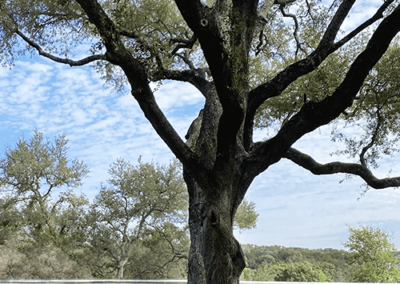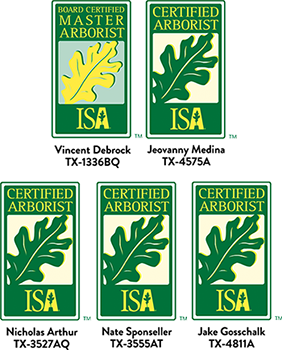Low maintenance and an appealing year-round view make artificial turf attractive to many property owners. While convenient, it is essential to take a critical look at how your plans affect your trees before installing the artificial turf.
Plan Now for Long-Term Benefits
When evaluating your project’s landscaping design, consider the possible long-term implications of today’s decisions, particularly as they relate to the health and care of your trees.
As arborists, our goal is to identify potential problems and present solutions that help you achieve your desired result while ensuring the trees can continue to thrive. The damage impulsive artificial turf installation causes may not manifest in outward signs of tree stress for several years.
A consultation with a certified arborist before your landscape project begins can save time, headache, and tree loss later.

Artificial Turf & Tree Impact
Trees add beauty and provide valuable shade. But as living things, they have vital requirements for long-term sustainability:
1. a healthy root system;
2. nutrient-rich aerated soil;
3. adequate moisture and drainage.
When installed without proper planning, artificial turf can limit the tree’s access to these essential requirements. A slow and steady decline of your valuable trees will be the result.
Root System
Drastic changes affecting the critical root zone (CRZ) will have the most significant immediate impact and should be carefully planned.
Trees have two significant kinds of roots; woody structural roots and non-woody feeder roots. Most roots exist in the top six to 24 inches of soil and extend away from the tree for a distance of two to seven times the size of the tree’s canopy.
Arborists can carefully probe and excavate using an AirSpade® tool to identify significant roots. This map can guide your landscape design process to minimize root damage.
Nutrients & Soil Aeration
Soil compaction is a leading cause of death for urban trees. Compressed soil prevents adequate air, nutrients, and water from reaching the roots. Unfortunately, installing artificial turf requires extensive soil compaction for proper installation.
Using machinery to remove vegetation and the several top layers of soil, installers prepare the soil to create a smooth surface for artificial turf installation. Often, herbicide is applied to prevent new vegetation from sprouting through the fake grass. Unfortunately, while it effectively kills new plants, this herbicide will negatively affect the trees at the same time.
Standard installation recommendations include using a vibrating compactor to pack the soil. Frequently, the soil is watered and compacted several times and topped with gravel to provide a smooth surface for the rolled-out synthetic lawn.
Compacted soil loses the tiny pores which typically hold water, which means the ground can’t absorb water for the tree to use. As a result, the tree struggles.
We performed microbial biomass testing with the microBIOMETER® system a year after artificial turf installation without compaction, and even without the compaction, we measured a significant reduction of soil nutrients after only one year. On that particular site, it convinced the homeowner to remove the artificial turf.
Moisture & Drainage
The compaction process during synthetic grass installation creates a virtually impervious layer that prevents water and vital nutrients from reaching the tree roots. In addition, the newly compacted soil causes extreme water runoff and prevents the deep soil saturation trees need to thrive.

Additionally, artificial grass installation often requires changing the soil grade around trees so the surface is leveled to installation standards. This process can create excessive and unnatural grade changes starting at the tree’s base, resulting in unplanned runoff and drainage issues.
Many municipalities have regulations governing activities that would cause these impacts, including the installation of artificial turf.
To find regulations in your area, search for tree ordinance [your municipality]. If you are in Texas, the Texas Chapter of the International Society of Arboriculture Texas Municipal Tree Ordinances may be a helpful place to begin your search.
Minimizing Tree Impact During & After Artificial Turf Installation
Soil is a living ecosystem. Healthy soil is full of microbes and mycorrhizal fungi, which make it possible for tree roots to absorb essential nutrients.
Removal of topsoil is part of the recommended installation process for artificial grass. Unfortunately, this includes the nutrient-rich topsoil that is essential for healthy trees.
Synthetic fertilizer can be applied, but it is not an adequate replacement for compost, nor can it infiltrate the compacted soil created during the installation. When artificial turf covers too much of the root zone, the tree won’t receive adequate nourishment and will eventually experience declining health and possibly die.

In urban landscapes, applying compost and mulch provides the ingredients that will eventually feed trees. This nutrient cycle is essential to the lifecycle of vigorous trees.
Often a few minor modifications to your plan can make a big difference in the long-term health of your trees. An experienced arborist can help you compare your landscape design plans to the critical root zones of trees on your property to ensure they can access the nutrients and water they need to survive and thrive.
Alternatives to Consider
People install artificial turf for many reasons, including water savings, ease of maintenance, and consistent visual appeal. However, other options exist to reach the same goals, which may be interesting to consider.
Some grass types thrive in the shade of mature trees and take little water. Native landscaping using sedge grass variations can help you achieve a green and low-maintenance landscape that will thrive and support the long-term health of your trees.
Finally, if you are determined to use artificial grass, you can consult an arborist with experience to help you alter your plans to minimize or prevent damage to your trees. They will help you modify your project to create a suitable compromise that considers the benefits you are looking for with artificial turf and the health and sustainability of your trees.
The arborists at Heritage Tree Care understand the value of the urban tree canopy and its contribution to the city landscape. They have experience working with landscape design projects that require caring for urban trees and helping them thrive alongside the people who love them. You can book a consultation today with Heritage Tree Care to have an arborist meet onsite to review your project.
Reference List:
Arborist, C. Tree and Natural Area Preservation. City of Austin. Retrieved March 31, 2023, from https://www.austintexas.gov/page/tree-and-natural-area-preservation
(2021, April 8). Artificial Turf Installation Guide. Artificial Grass Liquidators. Retrieved March 31, 2023, from https://www.artificialgrassliquidators.com/how-to-install-artificial-grass/
Chang, B., Wherley, B., Aitkenhead-Peterson, J. A., & McInnes, K. J. (2021, August 20). Effects of urban residential landscape composition on surface runoff generation. ScienceDirect. Retrieved March 31, 2023, from https://www.sciencedirect.com/science/article/abs/pii/S0048969721020477
City of Austin, Arborist. Levels of Tree Ordinance Protection. City of Austin. Retrieved March 31, 2023, from https://www.austintexas.gov/page/tree-reviews-and-permitting
Clement, D., Ph.D., Malinoski, M. K., Bosmans, R., Traunfeld, J., & Ricigliano, D. (2023, February 27). What Causes Trees and Shrubs to Die? Retrieved March 31, 2023, from https://extension.umd.edu/resource/what-causes-trees-and-shrubs-die
Fleming, P. R., Watts, C., & Forrester, S. (2020, October 20). A new model of third generation artificial turf degradation, maintenance interventions and benefits. Sage Journals. Retrieved March 31, 2023, from https://journals.sagepub.com/doi/full/10.1177/1754337120961602
(2022). ‘Greenness’ in the Eye of the Beholder: Comparing Perceptions of Sustainability and Well-being Between Artificial and Natural Turfgrass. Cities and the Environment (CATE), 15(1). https://doi.org/10.15365/cate.202.150102
Hillbert, D. R., Roman, L. A., A. K. K., Vogt, J., & Van Doorn, N. S. (2019, September 1). Urban Tree Mortality: A Literature Review. U.S. Department of Agriculture – Forest Service. Retrieved March 31, 2022, from https://www.fs.usda.gov/nrs/pubs/jrnl/2019/nrs_2019_hilbert_001.pdf
Kanaan, A., Sevostianova, E., Ph.D., Leinauer, B., Ph.D., & Sevostianov, I., Ph.D. (2020, October 1). Water Requirements for Cooling Artificial Turf. American Society of Civil Engineers Library. Retrieved March 31, 2023, from https://ascelibrary.org/doi/abs/10.1061/%28ASCE%29IR.1943-4774.0001506
Lombard, P. (2022, June 28). Synthetic Grass Can Be Deadly to Trees. Larchmont Buzz. Retrieved March 31, 2023, from https://larchmontbuzz.com/featured-stories-larchmont-village/synthetic-grass-can-be-deadly-to-trees/
(2023, February 28). Problems Caused by Compacted Soil. University of Maryland Extension. Retrieved March 31, 2023, from https://extension.umd.edu/resource/problems-caused-compacted-soil
STC Considerations When Buying Synthetic Grass for Landscape Use (2013). Synthetic Turf Council. Retrieved March 31, 2023, from https://www.syntheticturfcouncil.org/store/viewproduct.aspx?id=17587635
Welsh, D. F., Professor and Extension Horticulturalist, & Janne, E. E., Extension Landscape Horticulturist (deceased) (2008, November 1). Protecting Existing Landscape Trees from Construction Damage Due to Grade Changes. Texas A&M AgriLife Extension. Retrieved March 31, 2023, from https://aggie-horticulture.tamu.edu/earthkind/landscape/protecting-trees/
Join Us
Sign up for our newsletter to receive additional information about caring for your trees.








